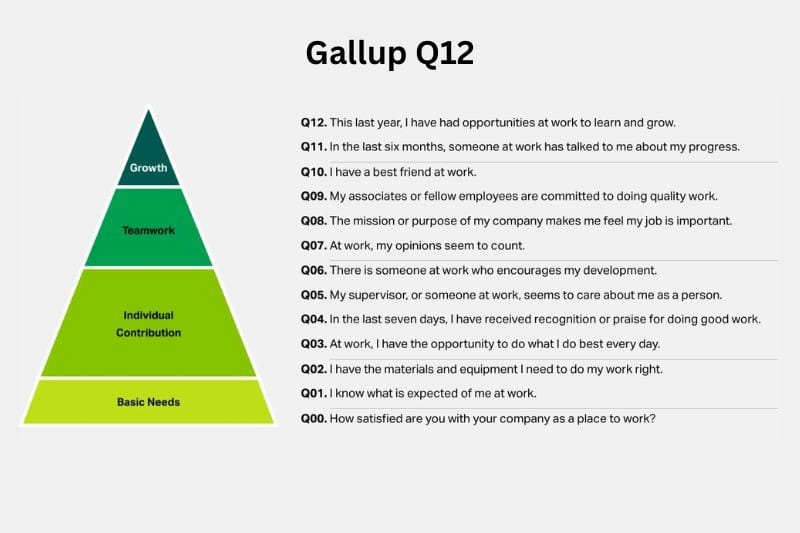Employee Engagement Survey Questions: The Ultimate Guide
Discover the best employee engagement survey questions to measure satisfaction and boost culture. Explore BuddiesHR to help you run surveys quickly and simply.

Keeping your finger on the pulse of employee sentiment is important because it tells you how you can better drive your company culture. But you’re no mind reader, and getting to grips with whether your workers are engaged can feel like a hit-and-miss project sometimes.
You’re keeping your ear to the ground, and it’s not rumbling (telling you there’s an obvious problem), but you’re sensing there’s something going on. The question is, how will you find out what it is? Stick around, and we’ll help you sort the wood from the trees. The short answer is 👇
Quick Overview
Employee engagement survey questions help you write structured and effective employee surveys. These surveys tell you where the gaps are in your company values, and how you can improve employee satisfaction.
Table of Contents
- What is an engagement survey?
- How to measure employee engagement
- Best survey questions to measure engagement
- How to structure pulse surveys
- Final Thoughts
- Frequently Asked Questions
What is an engagement survey?
Firstly, employee engagement is the involvement and enthusiasm employees have for their work and workplace. Employee engagement surveys are the measurement of the factors that keep workers involved. Global workplace metrics organization, Gallup, has for decades measured engagement with 12 workplace experiences, known as Gallup’s Q12. They found that companies with engaged employees have:
- 70% higher well-being
- 23% higher productivity
- 22% higher employee participation
- Between 21% - 55% less turnover
- 78% less absenteeism
🤓 Employee Net Promoter Scores (eNPS) are the employee engagement survey results that give you valuable insights into employee experience. They are a critical outcome of engagement surveys. Learn more in: How to run e-NPS in Slack in 2025
How to measure employee engagement
The work Gallup has done over 25 years gives insight and a clear direction into how to measure employee experience. Before setting up an employee satisfaction survey that tells you how your employees are doing, you need a tried and tested foundation for what creates employee engagement outcomes. Below is a summary of Gallup’s work on this subject.

Gallup.com
Gallup suggests that four basic levels of employee feedback lead to high team performance: Basic needs, individual contribution, teamwork, and growth. Understanding these needs sets up the pathway for managers to coach their employees. [1]
📊 Need to run an employee survey in a hurry? If you use Slack as your communication platform, it is possible to set up a survey in minutes with Pulsy Survey. Use pre-built templates, structure your questions and get a >90% response rate. 👉Set up Pulsy Survey.
Best survey questions to measure engagement
We’ve been discussing the usefulness of an engagement survey to drive critical business outcomes and keep your pulse on employee sentiment. The work environment can be a complex place where honest feedback is rare - mainly because employees feel it may affect peer relationships and their career development.
This makes the kind of survey questions very important. The best employee engagement survey questions will help you achieve good survey participation, which will ultimately lead to key business outcomes being met. The wrong questions will lead to further disconnection. [2] Here we provide a list of questions focused on actionable data.
20 Insightful questions on employee engagement

These twenty employee survey questions help you cover many critical engagement questions. This kind of survey can be done once a year - like an annual ‘health check-up’.
- I feel a sense of purpose in my day-to-day job.
- I feel that I am informed on the latest developments in my job.
- My manager greatly values my contributions and has expressed this.
- There is a culture of continuous improvement at this company.
- I know which path I need to take to meet my next career milestone.
- The most rewarding part of working for this company is shared successes.
- There is open and honest communication in my team.
- If I left this company, I would recommend it as a place of work for others.
- This workplace environment is conducive to achieving my goals.
- Company leadership is open to honest feedback without negative consequences.
- There is a good company reputation amongst the employees.
- I am given the proper tools that I need to be successful in my job.
- Someone in this company cares about my professional growth.
- My mental well-being is important to my superior.
- I feel informed about strategic decisions that affect my work.
- I clearly understand the values that drive the organization’s culture.
- I feel connected to my co-workers and get on well with most of them.
- I am given the right resources to complete my daily tasks.
- I feel empowered to address challenges that come up in my workplace.
- New skills are encouraged and valued in this company.
3 Bonus questions:
- Senior leadership is committed to the success of the company.
- I get continuous feedback that drives my performance forward.
- Employee motivation is something management should drive.
10 Good survey questions testing employee satisfaction

These ten employee engagement questions are important for testing employee satisfaction and cover work-life balance, employee perceptions, team dynamics, employee happiness, and workplace culture.
- Is this job good for your personal life and mental well-being?
- Have you been given opportunities for career progression in this company?
- Do you perceive that you have a good work-life balance at this company?
- Do you experience your manager as supporting your career goals?
- Have you been recognized for your contribution to the goals of this company?
- Are you satisfied with your current compensation structure?
- Are company values clearly communicated in this workplace?
- Do you get support in your day-to-day work?
- Do you feel a connection with other employees?
- Does someone at this company care about its future success?
5 Basic survey questions you can’t leave out

These five questions cover the areas of advocacy, alignment, management, and growth. If you want to send out a short survey and get to the heart of the matter, these questions will help.
- Have you given an opportunity to develop new knowledge and skills?
- Do you know exactly how your work contributes to the company's goals and objectives?
- Is it your experience that your manager knows how to help you meet your goals by giving useful feedback?
- Would you highly recommend this company to a friend as a place to work?
- Do you feel proud to work for this organization?
What do you do when you’ve got your survey results? Great question. In How To Improve Employee Engagement: 5 Actionable Strategies we share 5 concrete strategies for improving engagement.
How to structure pulse surveys

The most effective way to structure pulse surveys is according to themes. This provides not only effective data outcomes but also structured analytics. You will be able to break down data according to different categories and get quick insight into where you need to begin work on your culture.
Start with these five themes:
- Growth and development.
- Purpose and meaning.
- Leadership and company reputation.
- Peer relationships and culture.
- Work-life balance.
How the questions are structured is important for getting clear and honest answers from your employees. They should be written according to these simple rules:
- Closed questions: These questions either require a yes or no answer or provide a scale according to which employees can rate their answer. They are generally written as a statement or a question.
- Open-ended questions: These questions create reflection and invite a written response.
The clearer and more direct your questions are, the better the data you will extract from them. A badly written survey doesn’t get to the heart of what you’re trying to find out, and really becomes a waste of time.
Need help fast? Pulsy Survey in Slack is a super fast way of getting surveys done AND getting valuable insights. Access 58 questions in 12 themes with their built-in question bank. When you’re done, you’ll access results and insights from your Pulsy dashboard. Easy, fast, simple.
Final Thoughts
Employee engagement isn’t just about ticking boxes - it’s an ongoing and valuable dialogue between people, and it will always matter. Understanding how to structure survey questions to get to the root cause of your culture problems is an empowering skill to gain. Combine this skill with survey apps (like Pulsy Survey) to improve response rates and get valuable insights. These insights become the starting point for improvement and greater relationships at work.
Lilly Milev, Director of People at The RAD Consulting Group, writes about the Great Re-engagement in a time of burnout and uncertainty. She shares how you can ignite interest and motivation in your employees.
Frequently Asked Questions
1. What are the 5Cs of employee engagement?
The 5Cs of employee engagement are connection, communication, commitment, compensation, and care. Structure survey questions to include these five categories since they foster performance, culture engagement, and build trust.
2. How often should you run employee engagement surveys?
Staying on the pulse of employee satisfaction requires a comprehensive annual survey to measure bigger shifts in engagement. However, you should supplement this yearly survey with quarterly or monthly pulse surveys that alert you to smaller shifts in employee perception.
3. How can you improve engagement after running a survey?
The biggest shifts happen when there is transparency about the results. Share outcomes with your workers, and allow a short period for reflection and feedback. Invite employees to participate in problem-solving initiatives - and celebrate the things that you do well as a company.
4. What is the difference between employee satisfaction and engagement?
Both measure worker sentiment, but while engagement is often about emotional commitment, satisfaction is about comfort. These two terms are used interchangeably in the workplace, and the nuances between them can be missed - especially when drawing up employee surveys.
References:




